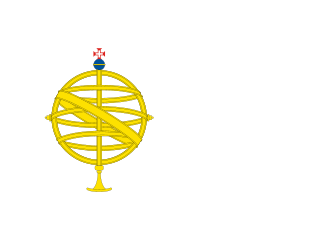 W
WColonial Brazil comprises the period from 1500, with the arrival of the Portuguese, until 1815, when Brazil was elevated to a kingdom in union with Portugal as the United Kingdom of Portugal, Brazil and the Algarves. During the early 300 years of Brazilian colonial history, the economic exploitation of the territory was based first on brazilwood extraction, which gave the territory its name; sugar production ; and finally on gold and diamond mining. Slaves, especially those brought from Africa, provided most of the work force of the Brazilian export economy after a brief period of Indian slavery to cut brazilwood.
 W
WDutch Brazil, also known as New Holland, was the northern portion of the Portuguese colony of Brazil, ruled by the Dutch during the Dutch colonization of the Americas between 1630 and 1654. The main cities of the Dutch colony of New Holland were the capital Mauritsstad, Frederikstadt, Nieuw Amsterdam (Natal), Saint Louis, São Cristóvão, Fort Schoonenborch (Fortaleza), Sirinhaém, and Olinda.
 W
WThe Bahian Conspiracy, also known as Revolt of the Tailors and recently also called Revolt of Buzios, was a late eighteenth century slave rebellion in the then Captaincy of Bahia, in the State of Brazil. Unlike the Inconfidência Mineira of 1789, it was a separatist movement with a popular base and extensive black participation.
 W
WAraribóia is the founder of the city of Niterói, in Brazil. In Tupi, his name means "ferocious snake".
 W
WThe Bandeirantes, literally "flag-carriers", were slavers, explorers, adventurers, and fortune hunters in early Colonial Brazil. They led expeditions carrying the Portuguese flag, the bandeira, claiming, by planting the flag, new lands for the Crown of Portugal. They are largely responsible for Brazil's great expansion westward, far beyond the Tordesillas Line of 1494, by which the Pope divided the new continent into a western, Castilian section, and an eastern, Portuguese section.
 W
WCaspar Barlaeus was a Dutch polymath and Renaissance humanist, a theologian, poet, and historian.
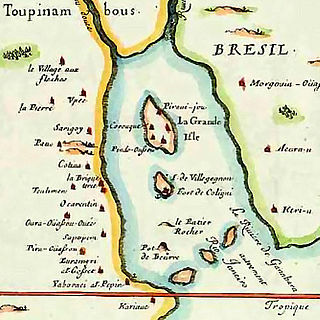 W
WThe Battle of Rio de Janeiro or the Battle of Guanabara Bay was a battle on 20 January 1567 at Rio de Janeiro that ended with the definitive defeat of the French. Specifically, the battle was an attack on the fortification of Uruçú-mirim. The Portuguese commander, Estácio de Sá, was hit by an arrow which perforated his eye, and died on 20 February.
 W
WThe Battle of São Vicente was a minor naval engagement that took place off São Vicente, Portuguese Brazil on 3 February 1583 during the Anglo–Spanish War between three English ships, and three Spanish galleons. The English under Edward Fenton on an expedition having failed to enter the Pacific, then attempted to trade off Portuguese Brazil but were intercepted by a detached Spanish squadron under Commodore Andrés de Equino. After a moonlit battle briefly interrupted by a rainstorm the Spanish were defeated with one galleon sunk and another heavily damaged along with heavy losses. Fenton then attempted to resume trading but without success and thus returned to England.
 W
WCerca do Macaco, also called "Cerca Real dos Macacos" or just "Macaco", was a historical settlement located on the peak of the Serra da Barriga in the state of Alagoas, Brazil. It was the main settlement of the Palmares, an established group of fugitives and escaped slaves.
 W
WHenrique Dias was a literate Afro-Brazilian soldier and militia leader born in the Portuguese colony of Brazil. There is no consensus among historians whether he was born free or captive.
 W
WJosé de Santa Rita Durão (1722–1784), known simply as Santa Rita Durão, was a Colonial Brazilian Neoclassic poet, orator and Augustinian friar. He is considered a forerunner of "Indianism" in Brazilian literature, with his epic poem Caramuru.
 W
WThe Dutch–Portuguese War was an armed conflict involving Dutch forces, in the form of the Dutch East India Company and the Dutch West India Company, against the Portuguese Empire. Beginning in 1602, the conflict primarily involved the Dutch companies invading Portuguese colonies in the Americas, Africa, India, and the Far East. The war can be thought of as an extension of the Eighty Years' War being fought in Europe at the time between Spain and the Netherlands, as Portugal was in a dynastic union with the Spanish Crown after the War of the Portuguese Succession, for most of the conflict. However, the conflict had little to do with the war in Europe and served mainly as a way for the Dutch to gain an overseas empire and control trade at the cost of the Portuguese. English forces also assisted the Dutch at certain points in the war. Because of the commodity at the center of the conflict, this war would be nicknamed the Spice War.
 W
WThe Treaty of El Pardo signed on 11 March 1778 finalised colonial borders between Spain and Portugal in the Río de la Plata region of South America. Portugal acquired Spanish territories in South America, later on given to Brazil, Spain acquired Portuguese territories in Africa, today known as the independent state of Equatorial Guinea.
 W
WEstrada Real is a set of colonial-era roads in Brazil.
 W
WA fazenda is a plantation found throughout Brazil; during the colonial period. They were concentrated primarily in the northeastern region, where (sugar) was produced, expanding during the 19th century in the southeastern region to coffee production. Fazenda now denotes any kind of farm in Brazilian Portuguese and occasionally in other Portuguese varieties as well.
 W
WVasco Fernandes Coutinho (1490–1561) was a Portuguese fidalgo and the first donatary of the Captaincy of Espírito Santo, a colonial territory in what is now Brazil.
 W
WFort Coligny was a fortress founded by Nicolas Durand de Villegaignon in Rio de Janeiro, Brazil in 1555, in what constituted the so-called France Antarctique historical episode.
 W
WFrancisco Xavier de Mendonça Furtado (1701–1769) served in Portugal's armed services rising in rank from soldier to sea-captain, then became a colonial governor in Brazil and finally a secretary of state in the Portuguese government. His major achievements included the extension of Portugal's colonial settlement in South America westward along the Amazon basin and the carrying out of economic and social reforms according to policies established in Lisbon.
 W
WTomás António Gonzaga was a Portuguese-born Brazilian poet. One of the most famous Neoclassic colonial Brazilian writers, he was also the ouvidor and the ombudsman of the city of Ouro Preto, as well as the desembargador of the appeal court in Bahia. He wrote under the pen name Dirceu.
 W
WThe Governorate General of Bahia was a colonial administration of the Portuguese Empire.
 W
WThe Governorate General of Brazil was a colonial administration of the Portuguese Empire in present-day Brazil. A governorate was equivalent in status to a viceroyalty, though the title viceroy didn't come into use until the early 18th century. They were ruled by a Governor General who reported to the Crown. The Governor General had direct authority over the constituent royal captaincies, and nominal but ill-defined authority over the donatary captaincies. One captaincy, that of Duarte Coelho in Pernambuco, was exempt by royal decree from the authority of the Governors General.
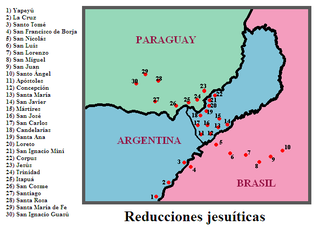 W
WThe Guarani War of 1756, also called the War of the Seven Reductions, took place between the Guaraní tribes of seven Jesuit Reductions and joint Spanish-Portuguese forces. It was a result of the 1750 Treaty of Madrid, which set a line of demarcation between Spanish and Portuguese colonial territory in South America.
 W
WHistory of a Voyage to the Land of Brazil, Also Called America, is an account published by the French Huguenot Jean de Léry in 1578 about his experiences living in a Calvinist colony in the Guanabara Bay in Rio de Janeiro, Brazil. After the colony dissolved, De Léry spent two months living with the Tupinambá Indians.
 W
WThe History of Pernambuco, a Brazilian state located in the country's Northeast region, dates back before its discovery by the Portuguese and includes the populations of the Caeté and Tabajara indigenous peoples. The name has represented different entities at different times: a captaincy, a province, an independent Republic (briefly), and today a state.
 W
WIlha de Vera Cruz was the first name given by the Portuguese navigators to the newly discovered land on the northeast coast of what later became known as Brazil. The name was later changed to Terra de Santa Cruz.
 W
WInconfidência Mineira was an unsuccessful separatist movement in Brazil in 1789. It was the result of a confluence of external and internal causes in what was then a Portuguese colony. The external inspiration was the independence of thirteen of the British colonies in North America following the American Revolutionary War, a development that impressed the intellectual elite of particularly the captaincy of Minas Gerais. The main internal cause of the conspiracy was the decline of gold mining in that captaincy. As gold became less plentiful, the region's gold miners faced increasing difficulties in fulfilling tax obligations to the crown, the tax over gold was one-fifth. When the captaincy could not satisfy the royal demand for gold, it was burdened with an additional tax on gold, called derrama.
 W
WThe Jesuit reductions were a type of settlement for indigenous people specifically in the Rio Grande do Sul area of Brazil, Paraguay and neighbouring Argentina in South America, established by the Jesuit Order early in the 17th century and wound up in the 18th century with the banning of the Jesuit order in several European countries. Subsequently it has been called an experiment in "socialist theocracy" or a rare example of "benign colonialism".
 W
WThe Kingdom of Brazil was a constituent kingdom of United Kingdom of Portugal, Brazil, and the Algarves.
 W
WLake Parime or Lake Parima is a legendary lake located in South America. It was reputedly the location of the fabled city of El Dorado, also known as Manoa, much sought-after by European explorers. Repeated attempts to find the lake failed to confirm its existence, and it was dismissed as a myth along with the city. The search for Lake Parime led explorers to map the rivers and other features of southern Venezuela, northern Brazil, and southwestern Guyana before the lake's existence was definitively disproved in the early 19th century. Some explorers proposed that the seasonal flooding of the Rupununi savannah may have been misidentified as a lake. Recent geological investigations suggest that a lake may have existed in northern Brazil, but that it dried up some time in the 18th century. Both "Manoa" and "Parime" are believed to mean "big lake".
 W
WLuís de Almeida Portugal Soares de Alarcão d'Eça e Melo Silva Mascarenhas, 2nd Marquess of Lavradio (27 June 1729 in Lisbon - 2 May 1790) was the 11th Viceroy of the Portuguese colony of Brazil, the second one that ruled the colony after the seat of government moved to Rio de Janeiro. He was the son of a Marquis of the same title, D. António de Almeida Soares e Portugal and his wife, D. Francisca das Chagas Mascarenhas. During the 1762 Spanish invasion of Portugal, he commanded the 1st Cascais Infantry Regiment.
 W
WFrancisco Barreto de Meneses was a military officer and a colonial administrator in the Portuguese colonies of São Tomé and Príncipe and Brazil.
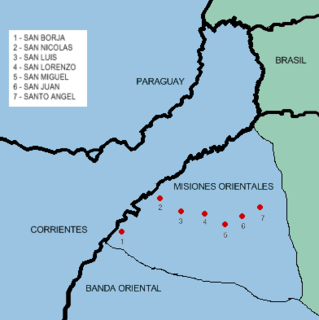 W
WThe Misiones Orientales (Spanish) or Sete Povos das Missões/Siete Pueblos de las Misiones (Portuguese) are a historic region in South America, in present-day Rio Grande do Sul, the southernmost State of Brazil.
 W
W W
WThe Spanish Imperial Governorate of New Toledo was formed from the previous southern half of the Inca Empire, stretching south into present day central Chile, and east into present day central Brazil.
 W
WManuel da Nóbrega was a Portuguese Jesuit priest and first Provincial of the Society of Jesus in colonial Brazil. Together with José de Anchieta, he was very influential in the early history of Brazil and participated in the founding of several cities, such as Recife, Salvador, Rio de Janeiro, and São Paulo, as well as many Jesuit colleges and seminaries.
 W
WPalmares, or Quilombo dos Palmares, was a quilombo, a community of escaped slaves and others, in colonial Brazil that developed from 1605 until its suppression in 1694. It was located in the captaincy of Pernambuco, in what is today the Brazilian state of Alagoas.
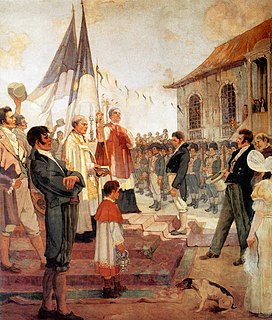 W
WThe Pernambucan revolt of 1817 occurred in the province of Pernambuco in the Northeastern region of Brazil, and was sparked mainly by the decline of sugar production rates and the influence of the Freemasonry in the region. Other important reasons for the revolt include: the ongoing struggle for the independence of Spanish colonies all over in South America; the independence of the United States; the generally liberal ideas that came through all of Brazil the century before, including many French Philosophers, such as Charles Montesquieu and Jean-Jacques Rousseau; the actions of secret societies, which insisted on the liberation of the colony; the development of a distinct culture in Pernambuco.
 W
WPortugal was a leading country in the European exploration of the world in the 15th century. The Treaty of Tordesillas in 1494 divided the Earth outside Europe into Castilian and Portuguese global territorial hemispheres for exclusive conquest and colonization. Portugal colonized parts of South America, but also made some unsuccessful attempts to colonize North America.
 W
WThe Portuguese invasion of the Banda Oriental was a short-lived and failed attempt, beginning in 1811 and ending the following year, by the Portuguese Empire to annex the remaining territory of the Spanish Viceroyalty of the Río de la Plata.
 W
WThe Portuguese conquest of the Banda Oriental was the armed-conflict that took place between 1816 and 1820 in the Banda Oriental, for control of what today comprises the whole of the Republic of Uruguay, the northern part of the Argentine Mesopotamia and southern Brazil. The four-year armed-conflict resulted in the annexation of the Banda Oriental into the United Kingdom of Portugal, Brazil and the Algarves as the Brazilian province of Cisplatina.
 W
WThe Real Audiencia of Quito was an administrative unit in the Spanish Empire which had political, military, and religious jurisdiction over territories that today include Ecuador, parts of northern Peru, parts of southern Colombia and parts of northern Brazil. It was created by Royal Decree on 29 August 1563 by Philip II of Spain in the city of Guadalajara. It ended in 1822 with the incorporation of the area into the Republic of Gran Colombia.
 W
WEstácio de Sá was a Portuguese soldier and officer. Sá travelled to the colony of Brazil on the orders of the Portuguese crown to wage war on the French colonists commanded by Nicolas Durand de Villegaignon. These French colonists had established themselves in 1555 at Guanabara Bay in Rio de Janeiro, in a settlement known as France Antarctique. He was the founder of Rio de Janeiro, now the second largest city in Brazil.
 W
WSão Miguel das Missões is a municipality in Rio Grande do Sul state, southern Brazil. Important 17th century Spanish Jesuit mission ruins are located in the municipality. San Miguel Mission is within Santo Ângelo Microregion, and the Riograndense Northwest Mesoregion. The city covers 1,246 square kilometres (481 sq mi) and had a population of 7,682 resident.
 W
WTomé de Sousa (1503–1579) was the first governor-general of the Portuguese colony of Brazil from 1549 until 1553. He was a nobleman and soldier born in Rates, Póvoa de Varzim. Sousa was born a noble and participated in military expeditions in Africa, fought the Moors and commanded the nau Conceição to Portuguese India, part of the armada of Fernão de Andrade.
 W
WThe State of Brazil was one of the states of the Portuguese Empire, in the Americas during the period of Colonial Brazil.
 W
WThe State of Grão-Pará and Maranhão was one of the states of the Portuguese Empire in Brazil.
 W
WThe State of Grão-Pará and Rio Negro was one of the states of the Portuguese Empire.
 W
WThe State of Maranhão was the northernmost of two 17–18th century administrative divisions of the colonial Portuguese Empire in South America.
 W
WThe State of Maranhão and Piauí was one of the states of the Portuguese Empire.
 W
WAntónio Raposo Tavares o Velho (1598–1658) was a Portuguese colonial bandeirante who explored mainland eastern South America and claimed it for Portugal, extending the territory of the colony beyond the limits imposed by the treaty of Tordesillas. He also led the largest expedition ever made in the Americas, covering over 10,000 kilometres around South America, unifying completely the two large South American river basins and the Andes in a single voyage. Raposo Tavares departed from São Paulo towards the rivers of the Río de la Plata Basin and the Andean slopes, and from there to Belém, at the mouth of the Amazon. Raposo Tavares was partly of Jewish origin according to the Jewish historian Anita Novinsky.
 W
WPedro Teixeira was a Portuguese explorer who became, in 1637, the first European to travel up the entire length of the Amazon River.
 W
WThe transfer of the Portuguese court to Brazil occurred with the strategic retreat of Queen Maria I of Portugal, Prince Regent John, and the Braganza royal family and its court of nearly 15,000 people from Lisbon on November 29, 1807. The Braganza royal family departed for the Portuguese colony of Brazil just days before Napoleonic forces invaded Lisbon on December 1. The Portuguese crown remained in Brazil from 1808 until the Liberal Revolution of 1820 led to the return of John VI of Portugal on April 26, 1821. For thirteen years, Rio de Janeiro, Brazil, functioned as the capital of the Kingdom of Portugal in what some historians call a metropolitan reversal. The period in which the court was located in Rio brought significant changes to the city and its residents, and can be interpreted through several perspectives. It had profound impacts on Brazilian society, economics, infrastructure, and politics. The transfer of the king and the royal court "represented the first step toward Brazilian independence, since the king immediately opened the ports of Brazil to foreign shipping and turned the colonial capital into the seat of government."
 W
WTropeiro is the designation given to troop and commissions drovers of horse, cattle and mule moving between commercial regions and consumer centers in Brazil from the 17th century.
 W
WThe Tupinambá are one of the various Tupi ethnic groups that inhabit present-day Brazil since before the conquest of the region by Portuguese colonial settlers. In the first years of contact with the Portuguese, the Tupinambás lived in the whole Eastern coast of Brazil, and the name was also applied to other Tupi-speaking groups such as the Tupiniquim, Potiguara, Tupinambá, Temiminó, Caeté, Tabajara, Tamoio, Tupinaé among others. In an exclusive sense, it can be applied to the Tupinambá peoples who once inhabited the right shore of the São Francisco river in the Recôncavo Baiano and from the Cabo de São Tomé in Rio de Janeiro to the town of São Sebastião in São Paulo. Their language survives today in the form of Nheengatu.
 W
WThe United Kingdom of Portugal, Brazil and the Algarves was a pluricontinental monarchy formed by the elevation of the Portuguese colony named State of Brazil to the status of a kingdom and by the simultaneous union of that Kingdom of Brazil with the Kingdom of Portugal and the Kingdom of the Algarves, constituting a single state consisting of three kingdoms.
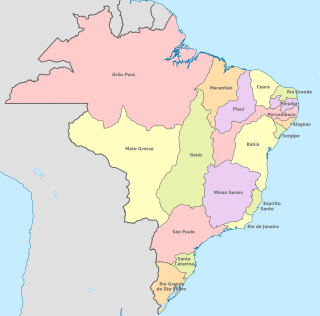 W
WThe Viceroyalty of Brazil refers, in narrow scope, to office of viceroy of the Portuguese colonial State of Brazil and, in broad scope, to the whole State of Brazil during the historic period when its governors had the title of "viceroy". The term "viceroyalty" however never officially designated the title of the colony, which continued to be designated "state". Until 1763, the title "Viceroy" was occasionally granted to some governors of Brazil who were members of the high nobility, with the remaining keeping the title "governor-general". From around 1763, the title "viceroy" became permanent, so being granted to all governors. The position of viceroy was abolished, when the Portuguese court transferred to Brazil in 1808, with the State of Brazil becoming directly administered by the Portuguese Government seated in Rio de Janeiro.
 W
WThe Viceroyalty of New Granada was the name given on 27 May 1717, to the jurisdiction of the Spanish Empire in northern South America, corresponding to modern Colombia, Ecuador, and Venezuela. Created in 1717 by king Felipe V, inside of a new territorial control policy, it was suspended in 1723 due to financial problems and was restored in 1739 until the independence movement suspended it again in 1810. The territory corresponding to Panama was incorporated later in 1739, and the provinces of Venezuela were separated from the Viceroyalty and assigned to the Captaincy General of Venezuela in 1777. In addition to these core areas, the territory of the Viceroyalty of New Granada included Guyana, southwestern Suriname, parts of northwestern Brazil, and northern Peru.
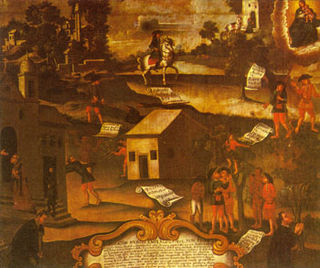 W
WThe War of the Emboabas was a conflict in colonial Brazil waged in 1706-1707 and 1708-1709 over newly discovered gold fields, which had set off a rush to the region between two generations of Portuguese settlers in the viceroyalty of Brazil - then the Captaincy of São Vicente. The discovery of gold set off a rush to the region, Paulistas asserted rights of discovery and non-Paulistas challenged their claims. Although the Portuguese crown sought more control in the area and the Paulistas sought protection of their claims, the Emoboabas won. The crown re-assessed its position in the region and made administrative changes subsequently.